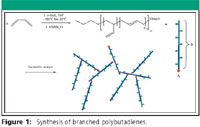Investigation of Branched Polydienes with GPC/MALS
The Application Notebook
Our work focuses on the synthesis of branched (functionalized) polydienes via a facile two-step synthesis. Despite the numerous strategies developed for the preparation of branched polymers in recent years, there is still a limited number of simple synthetic strategies based on common vinyl monomers.
Wyatt Technology Corporation
Our work focuses on the synthesis of branched (functionalized) polydienes via a facile two-step synthesis. Despite the numerous strategies developed for the preparation of branched polymers in recent years, there is still a limited number of simple synthetic strategies based on common vinyl monomers.

Table I: Molar mass comparisons
Linear polyisoprene and polybutadiene ABn-type macro-monomers were prepared by living anionic polymerization in THF (to ensure 1,2-addition) and terminated with chlordimethylsilane to get a terminal silane as the A-functionality of the macromonomer and the pendant vinyl groups of the polymer backbone as the B-functionalities. The macromonomers were reacted in a hydrosilylation polyaddition using Karstedt's catalyst to give branched polymers (Figure 1). We measured the macromonomers as well as the branched polymers using MALS. Even for the smallest macromonomer (Mn=1000) light scattering gives a reasonable result compared with NMR.

Figure 1
It is well-known that branched polymers elute later in a GPC-experiment than their linear analogues with same molecular weight, due to their compact architecture. So GPC alone can only give a rough estimation of the molar mass (because of polystyrene calibration). This becomes even more important when the double bonds are functionalized with small silanes, e.g. phenyldimethylsilane, which do not change the hydrodynamic radius of the polymer–and so show the same elution time as unfuntionalized polymers; the molecular weights are therefore drastically underestimated.

Figure 2

Figure 3
Using light scattering during the GPC experiment to determine the molar mass of the branched structures is an effective and rapid way to get quantitative information for the rate of functionalization and the molar mass (Figure 2). For the linear polymers, the molar mass can be determined, and for the branched structures, light scattering is the only way to get to real mass.

Wyatt Technology Corporation
6300 Hollister Avenue
Santa Barbara, CA 93117
TEL (805) 681-9009; FAX (805) 681-0123
E-mail: info@wyatt.com

Automated Sample Preparation (ISO 20122) for MOSH/MOAH in Seasoning Oils
May 6th 2025This work presents an Automated Sample Preparation procedure for MOSH/MOAH analysis of Seasoning Oils. We compare results from a manual epoxidation procedure compliant with DIN 16995 with results based on fully automated sample preparation (epoxidation and saponification) compliant with ISO 20122. In both cases, online clean-up via activated aluminum oxide (AlOx) are used to remove interfering n-alkanes from the MOSH fraction during the HPLC run. Automated data evaluation using a dedicated software (GERSTEL ChroMOH) is presented.
Free Poster: NDSRI Risk Assessment and Trace-Level Analysis of N-Nitrosamines
April 25th 2025With increasing concern over genotoxic nitrosamine contaminants, regulatory bodies like the FDA and EMA have introduced strict guidelines following several high-profile drug recalls. This poster showcases a case study where LGC and Waters developed a UPLC/MS/MS method for quantifying trace levels of N-nitroso-sertraline in sertraline using Waters mass spectrometry and LGC reference standards.

.png&w=3840&q=75)

.png&w=3840&q=75)



.png&w=3840&q=75)



.png&w=3840&q=75)














